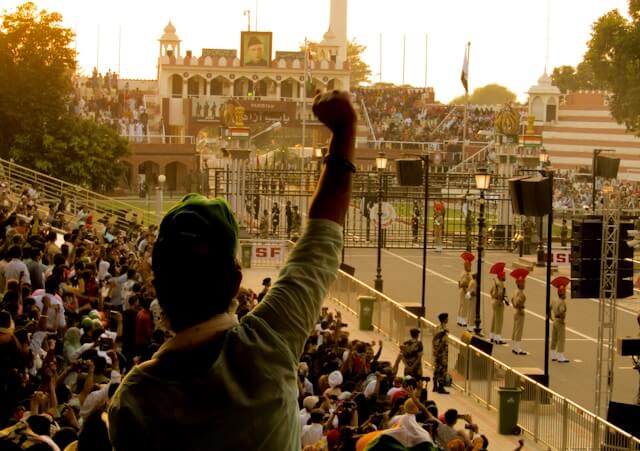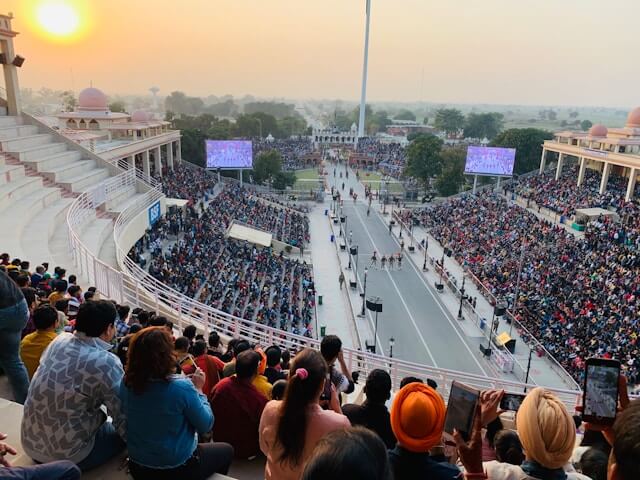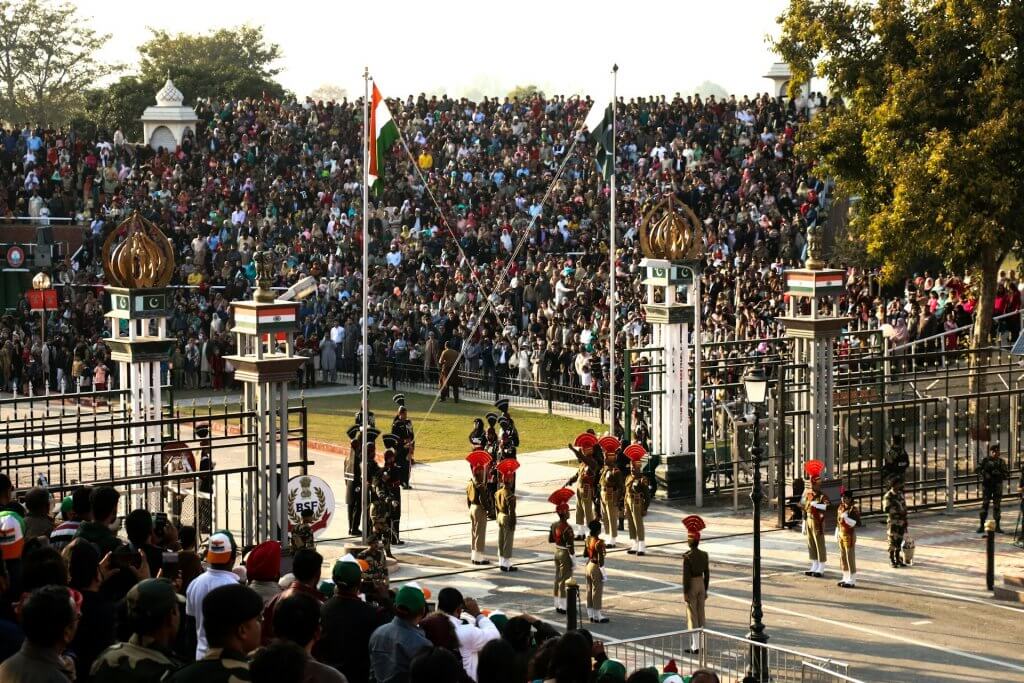Have you ever witnessed a spectacle so vibrant and filled with national pride that it left you awestruck? Well, if you haven’t, then you’re in for a treat! The Wagah Border Ceremony, situated near Amritsar, is a mesmerizing display of patriotism and military precision that attracts visitors from all corners of the globe. In this article, we’ll delve into the intricacies of this iconic ceremony, from its timing to entry fee details and everything in between.
The Wagah Border Ceremony stands as a symbol of the enduring spirit and patriotism of India and Pakistan. Located at the border between the two nations, near the city of Amritsar in Punjab, this daily military ceremony attracts visitors from around the world who come to witness the electrifying display of national pride and fervor. In this guide, we invite you to delve into the heart of this extraordinary spectacle and discover the essence of the Wagah Border Ceremony.
Contents
- 1. Understanding the Significance
- 2. Timing of the Ceremony
- 3. Location and How to Get There
- Getting There
- 4. Entry Fee Details
- 5. What to Expect
- 6. The Rituals and Traditions
- 7. The Symbolism Behind the Wagah Border Rituals
- 8. Dos and Don’ts for Visitors
- 9. Nearby Attractions
- 10. Capturing Memories: Photography Tips
- 11. A Glimpse into the Cultural Extravaganza Virtually
- 12. The Impact of the Ceremony on Visitors
- Frequently Asked Questions About the Ceremony
- 1. What is the significance of the Wagah Border Ceremony?
- 2. When does the Wagah Border Ceremony take place?
- 3. Is there an entry fee to witness the Wagah Border Ceremony?
- 4. Are photography and videography allowed during the ceremony?
- 5. How can I experience the Wagah Border Ceremony if I can’t visit in person?
- Related posts:
- 8 Thrilling Things To Do in Mumbai for Adventure Junkies
- Top 10 Things To Do in Sri Lanka on a Holiday
- Top 10 Things To Do in Kandy, Sri Lanka
- Best Tours & Excursions In and Around Goa
- A Comprehensive Bangalore Sightseeing Guide: City's Top Tourist Attractions
- 12 Fun Things To Do in Rajasthan
- The Ultimate Sri Lanka Travel Guide
- Top 20 Places To Visit In Bangalore
1. Understanding the Significance
The Wagah Border Ceremony traces its origins back to 1959 when India and Pakistan agreed to conduct a daily ritual of lowering the flags at sunset to mark the closing of the border. Over the years, the ceremony has evolved into a grand spectacle, characterized by elaborate drills, synchronized marches, and vibrant displays of patriotism. It serves as a symbol of the longstanding rivalry and occasional cooperation between the two nations, while also showcasing the shared cultural heritage and traditions of the people of the Indian subcontinent.
The Wagah Border Ceremony holds immense significance for both India and Pakistan. It symbolizes the closing of the border gates and the lowering of the flags, marking the end of each day with a display of military pageantry and national pride.
2. Timing of the Ceremony
The Wagah Border Ceremony takes place every evening before sunset, attracting thousands of spectators who gather on both sides of the border to witness the spectacle. The ceremony begins with the lowering of the flags by the respective border guards, followed by a meticulously choreographed drill performance that includes high kicks, stomping of feet, and elaborate hand gestures. The atmosphere is charged with excitement and emotion as patriotic songs blare from loudspeakers, and spectators wave flags and chant slogans in support of their respective countries.
OPENING TIME
Open Daily:
Mon – Sat: 9:00 am – 6:00 pm
Retreat Ceremony Timing
16:00Hrs (Everyday)
Duration
60 min – 120 min
It’s essential to arrive early to secure a good viewing spot as the area tends to get crowded quickly, especially on weekends and holidays.
https://www.trodly.com/activity-3711-amritsar-local-sightseeing-day-tour
3. Location and How to Get There
Situated near Amritsar in Punjab, India, reaching the Wagah Border is relatively easy. Visitors can opt for taxis, buses, or private vehicles to travel to this iconic location.
Address: Joint Check Post, BSF, Attari, Amritsar
Getting There
By Air:
The nearest airport to the Wagah Border is Sri Guru Ram Dass Jee International Airport in Amritsar. From the airport, you can hire a taxi or take a pre-booked cab to reach the border.
By Train:
Amritsar Railway Station is well-connected to major cities across India. From the railway station, you can hire a taxi or take a local bus to reach the Wagah Border.
By Road:
If you’re traveling by road, you can hire a taxi or take a local bus from Amritsar to reach the Wagah Border. The journey takes approximately 45 minutes to one hour, depending on traffic conditions.
4. Entry Fee Details
Good news! There is no entry fee to witness this awe-inspiring ceremony. However, it’s advisable to carry some cash for miscellaneous expenses like parking fees or refreshments.
You can book a seat on BSF website here
Entry Requirements
Visitors to the Wagah Border Ceremony are required to carry valid identification documents such as a passport, Aadhar card, or driver’s license for entry into the designated viewing areas. It’s essential to arrive early and follow the instructions of security personnel to ensure a smooth entry process.
5. What to Expect
Get ready to witness a breathtaking display of synchronized marching, elaborate uniforms, and a fervent display of patriotism from both sides of the border. The atmosphere is electric, filled with cheers and chants from the spectators.

For visitors, witnessing the Wagah Border Ceremony is a once-in-a-lifetime experience that leaves a lasting impression. The electrifying atmosphere, colorful attire, and spirited chants create an atmosphere of celebration and unity, transcending national boundaries and fostering a sense of camaraderie among spectators. Visitors are advised to arrive early to secure a good vantage point and to carry valid identification documents for entry into the designated viewing areas.
Elaborate Drill Performances:
The Wagah Border Ceremony features elaborate drill performances by the border guards from both India and Pakistan. The synchronized movements, high kicks, and spirited marches are a sight to behold, showcasing the precision and discipline of the armed forces.
Lowering of the Flags:
The highlight of the ceremony is the lowering of the national flags of India and Pakistan, which symbolizes the closing of the border for the night. This ritual is conducted with great pomp and ceremony, accompanied by patriotic songs and chants from the crowd.
Beating Retreat Ceremony:
Towards the end of the ceremony, there is a “Beating Retreat” ceremony where soldiers from both sides engage in a handshake and exchange pleasantries. This symbolic gesture represents goodwill and cooperation between the two nations, despite political tensions.
6. The Rituals and Traditions
The ceremony follows a strict protocol, with soldiers from both sides engaging in intricate drill movements and flag-lowering ceremonies. It’s a well-choreographed performance that leaves spectators spellbound.
At the heart of the Wagah Border Ceremony lies a deep sense of symbolism and ritual. The synchronized movements of the border guards symbolize the precision and discipline of the armed forces, while the lowering of the flags signifies the peaceful closure of the border for the night. The exchange of handshakes between the soldiers from both sides, known as the “Beating Retreat” ceremony, symbolizes goodwill and cooperation, albeit amidst the backdrop of political tensions and territorial disputes.
https://www.trodly.com/activity-3713-2-days-guided-tour-of-amritsar-city-in-private-vehicle
7. The Symbolism Behind the Wagah Border Rituals
The Wagah Border has a rich historical significance, dating back to the partition of India in 1947. It serves as a reminder of the shared history and cultural ties between India and Pakistan.

8. Dos and Don’ts for Visitors
To ensure a smooth and enjoyable experience, visitors are advised to follow certain guidelines. Do arrive early, carry valid identification, and refrain from any provocative behavior. Don’t carry large bags or prohibited items.
Tips for Visitors
To make the most of your visit to the Wagah Border Ceremony, here are some useful tips:
- Arrive Early: To secure a good viewing spot, it’s advisable to arrive at least an hour before the ceremony begins.
- ID: Carry valid identification documents for entry.
- Travel Lite: Avoid carrying large bags or backpacks.
- Dress Appropriately: As the Wagah Border Ceremony is a solemn occasion, visitors are advised to dress modestly and respectfully.
- Stay Hydrated: The ceremony can last for over an hour, so it’s essential to stay hydrated and carry water bottles with you.
- Follow Instructions: Follow the instructions of security personnel and staff to ensure a safe and enjoyable experience.
- Respect Cultural Differences: Remember to respect the cultural differences and traditions of both India and Pakistan during your visit.
- Expect Crowd: Be prepared for large crowds and long wait times.
9. Nearby Attractions
While you’re in the vicinity, don’t miss out on exploring other attractions such as the Golden Temple, Jallianwala Bagh, and the bustling streets of Amritsar, known for their delectable cuisine.
https://www.trodly.com/activity-2335-freedom-struggle-tour-of-amritsar-with-wagah-border
10. Capturing Memories: Photography Tips
Photography enthusiasts, rejoice! Capture the essence of the ceremony with these handy tips: arrive early to secure a good vantage point, use a zoom lens for close-up shots, and don’t forget to charge your camera battery.
11. A Glimpse into the Cultural Extravaganza Virtually
Can’t make it to the Wagah Border in person? No worries! You can experience the ceremony virtually through live streams and videos available online. Though nothing beats the thrill of witnessing it firsthand, virtual experiences offer a glimpse into this iconic event.
https://www.trodly.com/activity-865-2-day-amritsar-sightseeing-tour
12. The Impact of the Ceremony on Visitors
For many visitors, witnessing the Wagah Border Ceremony is a deeply moving experience that fosters a sense of national pride and unity. It serves as a poignant reminder of the shared history and cultural heritage of the region.
In conclusion, the Wagah Border Ceremony is more than just a military ritual; it’s a testament to the enduring spirit of patriotism and camaraderie between India and Pakistan. Whether you’re a local or a tourist, experiencing this spectacle is a must-do activity that promises to leave a lasting impression.
Frequently Asked Questions About the Ceremony
1. What is the significance of the Wagah Border Ceremony?
The ceremony symbolizes the closing of the border gates between India and Pakistan, marking the end of each day with a display of military pageantry and national pride.
2. When does the Wagah Border Ceremony take place?
The ceremony takes place every evening before sunset, attracting visitors from all over the world to witness this awe-inspiring spectacle.
3. Is there an entry fee to witness the Wagah Border Ceremony?
No, there is no entry fee to witness the ceremony. However, visitors are advised to arrive early to secure a good viewing spot.
4. Are photography and videography allowed during the ceremony?
Yes, photography and videography are allowed during the ceremony. Visitors are encouraged to capture the memorable moments but are requested to refrain from obstructing the view of others.
5. How can I experience the Wagah Border Ceremony if I can’t visit in person?
You can experience the ceremony virtually through live streams and videos available online. Though nothing beats witnessing it firsthand, virtual experiences offer a glimpse into this iconic event.
Get ready to immerse yourself in the electrifying atmosphere of the Wagah Border Ceremony and witness a cultural spectacle like no other!

